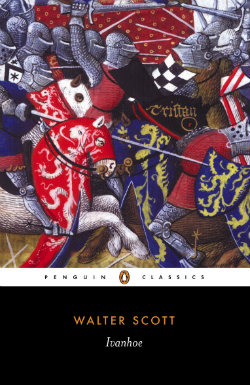 Ivanhoe? How’d that end up on my reading list, you ask? Two reasons: a Book Riot article about Game of Thrones and Ivanhoe put it on my radar in the first place, then seeing Sir Walter Scott mentioned in so many other books (none of which I can think of, of course) finally did me in. Evidently, back in the day, Scott was super popular with both kids and adults. Maybe like an early nineteenth-century J.K. Rowling? People loved his adventure stories. Now, of course, he’s fallen out of fashion, I guess because more modern audiences have difficulty with his language. I really don’t know, except that I hear so many complaints about “old books” and how hard they are to read. Like Shakespeare wasn’t written in English.
Ivanhoe? How’d that end up on my reading list, you ask? Two reasons: a Book Riot article about Game of Thrones and Ivanhoe put it on my radar in the first place, then seeing Sir Walter Scott mentioned in so many other books (none of which I can think of, of course) finally did me in. Evidently, back in the day, Scott was super popular with both kids and adults. Maybe like an early nineteenth-century J.K. Rowling? People loved his adventure stories. Now, of course, he’s fallen out of fashion, I guess because more modern audiences have difficulty with his language. I really don’t know, except that I hear so many complaints about “old books” and how hard they are to read. Like Shakespeare wasn’t written in English.
Walter Scott, of course, is no Shakespeare.
But he writes a damn fine story. Ivanhoe is set in twelfth-century England, when Richard I was king. Ivanhoe, a knight, has just returned from Palestine and appears at Cedric the Saxon’s house in disguise, peniless and destitute. No one knows who he is. There, he meets a Jewish man, Isaac, who he rescues from Normans who plan to kidnap him, and in return, Isaac loans Ivanhoe a horse and armor to fight in a tournament for Prince John, Richard’s brother. Richard is supposedly off in Palestine, and John has dreams of becoming king, so he acts like (a bad) one. On the first day of the tournament, Ivanhoe wins the joust. There’s a melee the next day, and Ivanhoe wins that, too, thanks to a mysterious knight dressed in all black who runs off after the fight. Another mysterious man named Locksley wins the archery competition. This book is full of disguises. After all of this is over, Ivanhoe reveals himself, and we discover that he is Cedric’s son. He had chosen Cedric’s ward, Rowena, as queen of the tournament – he had plans to marry her before he went to Palestine. After he removes his helmet, though, he falls down because he’s been wounded, after which Isaac’s daughter, Rebecca, applies secret Jewish balms that are later attributed to sorcery. Prince John is none too happy, and Cedric sneaks Isaac and Rebecca off with Ivanhoe in a litter so he can recover in a more friendly atmosphere. They meet up on the road and are assaulted by robbers, and most of them are kidnapped and end up at a Norman castle. I’ll stop here. This summary only covers the first third of the book, or so, if that much. It’s a complicated plot. But Robin Hood makes an appearance! Good stuff.
I liked Ivanhoe even more than I thought I would. I was a little worried at the beginning because Scott enjoys extensive description a little more than I do, but I got into it quickly, and the story moved at a nice pace. I hadn’t heard anything, really, about the plot, but I found it very predictable, as I guess books of this era tend to be. What I wasn’t expecting was that prejudice against the Jewish characters drove the storyline more than just about anything else. I guess I hadn’t thought about such prejudice beyond The Merchant of Venice. I was sad and a little disturbed.
Anyway, Ivanhoe is worth a read. It’s long, but it’s time well spent. The story is good, and the characters are all interesting and entertaining. It can seem a bit daunting at the beginning, but get through the first few pages, and you’ll be hooked. It’s a classic for a reason.